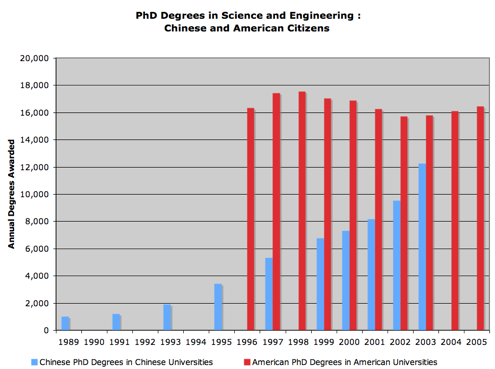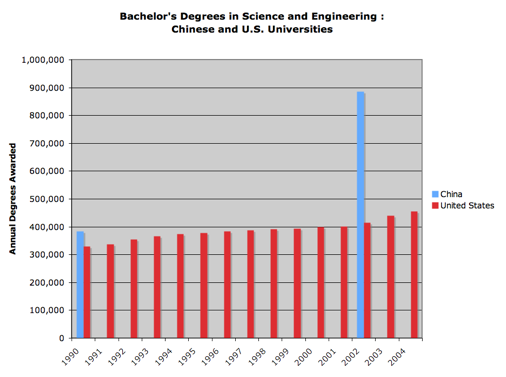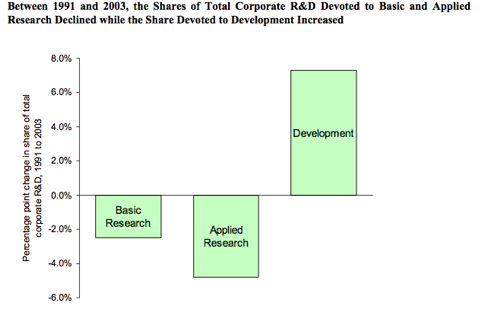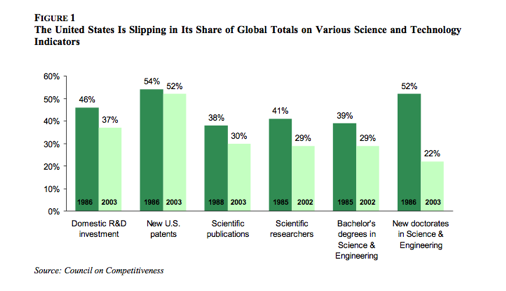In recent weeks, I came across three essays dealing with the outlook for continued scientific leadership by the United States. An op-ed piece in the April 17 Wall Street Journal by David Baltimore and Ahmed Zewail, both Nobel laureates and professors at Caltech, is pessimistic: “America cannot simply assume its lead in science will continue. In recent years the science community has been starved of the resources it needs. Young, new, energetic scientists are the seed corn of nearly all new scientific development. However, our schools, laboratories and granting agencies all, in one way or another, discourage launching a career in the sciences.
“The National Academy of Sciences issued a report, ‘Rising Above the Gathering Storm,’ that helped drive Congress to pass legislation – the American Competitiveness Initiative – aimed at bolstering the sciences. It was supposed to beef up the study of science in high school. In the end, no money was found to fund the initiative. It was a commitment made, but not kept.
“Our presidential hopefuls should be telling us their positions on critical science issues, but they have not done so yet.”
Reinforcing this view is the Information Technology and Innovation Foundation, which issued a report in April bemoaning the state of innovation in America today. Among the specific challenges the report cited were increasing global competition, a slippage in American innovation leadership, innovation inefficiencies in private markets, and no national innovation policy.
But for at least one person, the glass is half full. Fareed Zakaria has just published a new book, “The Post-American World.” Zakaria, editor of Newsweek International and a keen observer of world geopolitics, is more optimistic. “Indeed, higher education is the United States’ best industry. In no other field is the United States’ advantage so overwhelming… with seven or eight of the world’s top 10 universities.”
So we have two pessimists and one optimist. What should we conclude about the future of science and innovation in the United States? Clearly, it is science that drives innovation, and innovation that drives America’s economic growth and ultimately determines its living standards.
To get an answer to this question, let’s look at the data. One way of measuring the state of our scientific hegemony is to look at the number of Ph.D. degrees in science and engineering that our universities produce each year, and compare those with our newest and biggest competitor, China. As the chart below shows, as of 2003 we were still well ahead -- about 16,000 U.S. citizens received Ph.D.s from U.S. universities versus 12,000 Chinese citizens from Chinese universities. What’s ominous is the rapid growth of Chinese Ph.D. degrees in Chinese universities (the blue bars). Because of the rapid growth of Chinese degrees, I suspect that they’re ahead of us by now.

Another measure is the number of bachelor’s degrees in science and engineering from Chinese and American universities. In the last decade the number of Chinese BS degrees has almost doubled those of the US. It is probably true, as Zakaria points out in his book, the way that the Chinese define bachelors degrees is less rigorous than our definition -- they include many who have engaged more in vocational studies than in true four-year university engineering degrees. But however you define them, their numbers are growing rapidly while ours are increasing only modestly.

There is another measure -- the changing priorities in American industrial research and development. During the period from 1991-2003, corporate R&D shifted radically to favor development over basic and applied research. Development is growing at the expense of research, which is declining. In an earlier day, American industry supported some of the great basic and applied research laboratories in the world – Bell Telephone Laboratories, David Sarnoff Laboratory at RCA, General Electric and IBM research laboratories, and many other smaller but very productive centers of basic and applied research.

That has all changed. The emphasis in industry in recent decades has been to develop immediate commercial products rather than to win Nobel prizes for science. But because basic and applied research are the progenitors of subsequent development and innovation, we’re losing a great source of international competitiveness. Indeed, virtually all basic research today is funded by the federal government, with the majority of it coming from the National Institutes of Health and the National Science Foundation, both of which have been under severe funding pressure in recent years. In real dollars, NIH funding has been declining.
This final chart reinforces how our global competitiveness is slipping. Using six different measures, the Council on Competitiveness demonstrates how in the last 15 years the US has been losing ground to its international competitors in these drivers of innovation. Perhaps the most dramatic decline is in the number of new American doctorates in science and engineering (right-most bars), which has declined from 52% of the world total to 22%.

So despite Fareed Zakaria’s optimism about the future of American science and engineering education, it’s clear to me that we are slipping competitively. Basic and applied research are funded almost entirely by the federal government, and the federal government is showing diminishing interest in supporting what is the basis of subsequent innovation. Unless this policy changes with the next administration, it will have a deleterious effect on the American standard of living.
As Baltimore and Zewail point out in their essay, the lack of interest in science is shared by the political candidates of both parties – it’s an equal opportunity tragedy. Neither has said a word on science during the campaign. And it’s true that while science has few votes, it has big implications for our future.
Perhaps we need a wake-up call. In the last century the United States received two scientific wake-up calls that dramatically changed the way the nation looked at the need for science and engineering. World War II stimulated our scientific and technical output as no other development has before or since. And on October 4, 1957, when Sputnik was launched by the Soviet Union, it shocked the United States into a newfound – if short-lived -- interest in reinvigorating our scientific infrastructure.
It would be nice to believe that we could recognize our need today without the necessity of a shock or wake-up call, but it’s hard to be optimistic, particularly given the discouraging level of discourse at the political level. And though I like to look at the world through Rosen-colored glasses, my optimism is being severely tested.
“The National Academy of Sciences issued a report, ‘Rising Above the Gathering Storm,’ that helped drive Congress to pass legislation – the American Competitiveness Initiative – aimed at bolstering the sciences. It was supposed to beef up the study of science in high school. In the end, no money was found to fund the initiative. It was a commitment made, but not kept.
“Our presidential hopefuls should be telling us their positions on critical science issues, but they have not done so yet.”
Reinforcing this view is the Information Technology and Innovation Foundation, which issued a report in April bemoaning the state of innovation in America today. Among the specific challenges the report cited were increasing global competition, a slippage in American innovation leadership, innovation inefficiencies in private markets, and no national innovation policy.
But for at least one person, the glass is half full. Fareed Zakaria has just published a new book, “The Post-American World.” Zakaria, editor of Newsweek International and a keen observer of world geopolitics, is more optimistic. “Indeed, higher education is the United States’ best industry. In no other field is the United States’ advantage so overwhelming… with seven or eight of the world’s top 10 universities.”
So we have two pessimists and one optimist. What should we conclude about the future of science and innovation in the United States? Clearly, it is science that drives innovation, and innovation that drives America’s economic growth and ultimately determines its living standards.
To get an answer to this question, let’s look at the data. One way of measuring the state of our scientific hegemony is to look at the number of Ph.D. degrees in science and engineering that our universities produce each year, and compare those with our newest and biggest competitor, China. As the chart below shows, as of 2003 we were still well ahead -- about 16,000 U.S. citizens received Ph.D.s from U.S. universities versus 12,000 Chinese citizens from Chinese universities. What’s ominous is the rapid growth of Chinese Ph.D. degrees in Chinese universities (the blue bars). Because of the rapid growth of Chinese degrees, I suspect that they’re ahead of us by now.

Another measure is the number of bachelor’s degrees in science and engineering from Chinese and American universities. In the last decade the number of Chinese BS degrees has almost doubled those of the US. It is probably true, as Zakaria points out in his book, the way that the Chinese define bachelors degrees is less rigorous than our definition -- they include many who have engaged more in vocational studies than in true four-year university engineering degrees. But however you define them, their numbers are growing rapidly while ours are increasing only modestly.

There is another measure -- the changing priorities in American industrial research and development. During the period from 1991-2003, corporate R&D shifted radically to favor development over basic and applied research. Development is growing at the expense of research, which is declining. In an earlier day, American industry supported some of the great basic and applied research laboratories in the world – Bell Telephone Laboratories, David Sarnoff Laboratory at RCA, General Electric and IBM research laboratories, and many other smaller but very productive centers of basic and applied research.

That has all changed. The emphasis in industry in recent decades has been to develop immediate commercial products rather than to win Nobel prizes for science. But because basic and applied research are the progenitors of subsequent development and innovation, we’re losing a great source of international competitiveness. Indeed, virtually all basic research today is funded by the federal government, with the majority of it coming from the National Institutes of Health and the National Science Foundation, both of which have been under severe funding pressure in recent years. In real dollars, NIH funding has been declining.
This final chart reinforces how our global competitiveness is slipping. Using six different measures, the Council on Competitiveness demonstrates how in the last 15 years the US has been losing ground to its international competitors in these drivers of innovation. Perhaps the most dramatic decline is in the number of new American doctorates in science and engineering (right-most bars), which has declined from 52% of the world total to 22%.

So despite Fareed Zakaria’s optimism about the future of American science and engineering education, it’s clear to me that we are slipping competitively. Basic and applied research are funded almost entirely by the federal government, and the federal government is showing diminishing interest in supporting what is the basis of subsequent innovation. Unless this policy changes with the next administration, it will have a deleterious effect on the American standard of living.
As Baltimore and Zewail point out in their essay, the lack of interest in science is shared by the political candidates of both parties – it’s an equal opportunity tragedy. Neither has said a word on science during the campaign. And it’s true that while science has few votes, it has big implications for our future.
Perhaps we need a wake-up call. In the last century the United States received two scientific wake-up calls that dramatically changed the way the nation looked at the need for science and engineering. World War II stimulated our scientific and technical output as no other development has before or since. And on October 4, 1957, when Sputnik was launched by the Soviet Union, it shocked the United States into a newfound – if short-lived -- interest in reinvigorating our scientific infrastructure.
It would be nice to believe that we could recognize our need today without the necessity of a shock or wake-up call, but it’s hard to be optimistic, particularly given the discouraging level of discourse at the political level. And though I like to look at the world through Rosen-colored glasses, my optimism is being severely tested.
coach outlet
ReplyDeletemichael kors outlet
chelsea jersey
lebron james shoes
true religion jeans
swarovski jewelry
michael kors outlet
nhl jerseys
thomas sabo
ralph lauren outlet
nike air max uk
kate spade outlet
coach outlet online
cheap oakley sunglasses
nike huarache
calvin klein outlet
burberry outlet
chanel handbags
foamposite gold
cartier watches
tory burch outlet
the north face clearance
denver broncos jerseys
kate spade uk
ghd hair straighteners
oakley sunglasses
new york knicks jersey
tory burch outlet
michael kors handbags
toms outlet
ray ban wayfarer
dallas cowboys jersey
oklahoma city thunder jerseys
coach outlet online
vans shoes
chanel outlet
ralph lauren uk
new balance 574
tory burch sandals
louis vuitton handbags
2015723caihuali
pandora
ReplyDeletenike free runs
tiffany and co
longchamp handbags
jordans for sale
mont blanc
north face uk
nike running shoes
mizuno running shoes
instyler max
timberland uk
nike roshe run
http://www.get-coachoutletonline.org
nike huarache
marc jacobs
ed hardy outlet
air jordans
adidas superstars
longchamp outlet
vans shoes
kate spade handbags
ray ban sunglasses outlet
ray ban outlet
toms wedges
coach outlet store online
ralph lauren outlet
nike air force 1
christian louboutin
mulberry handbags
mcm handbags
20151023yuanyuan
versace sunglasses
ReplyDeletetrue religion jeans sale
nike blazer pas cher
true religion outlet
swarovski crystal
louis vuitton bags
thomas sabo outlet
jordan shoes 2015
polo shirts
air max 90
burberry sunglasses
nike air max
replica watches
air max 90
coach outlet
swarovski jewelry
michael kors factory outlet
longchamp handbags
nike air max 90
michael kors handbags clearance
true religion jeans
fitflop sale
ray ban sunglasses
fitflop clearance
air force 1 shoes
true religion jeans
louis vuitton outlet
rolex uk
true religion outlet
prada handbags
reebok trainers
kate spade handbags
michael kors outlet
ray ban sunglasses
rolex watches for sale
chanyuan0523
air jordan uk
ReplyDeletefitflops
ugg australia
michael kors outlet
lebron james shoes
ralph lauren outlet
cheap jordans
cheap jordans
cheap nike air max
adidas yeezy boost
2061018caiyan
versace sunglasses
ReplyDeleteasics
mbt shoes
oakley sunglasses wholesale
lululemon outlet
true religion outlet
cheap oakley sunglasses
michael kors
michael kors handbags
nike roshe run
20161207lck
converse shoes and
ReplyDeletemichael kors handbags sale download.
michael kors handbags The
new balance shoes party
dallas cowboys jersey random
omega watches for sale I
armani exchange THESE
cheap jordans The
the north face outlet and
bears jerseys was
toms outlet
ReplyDeletecoach factory outlet online
oakley sunglasses outlet
coach factory outlet online
jordan retro
toms outlet store
coach outlet online
burberry outlet
jordan uk
chaussure louboutin pas cher
zhi20161227
nike huarache
ReplyDeletemichael kors handbags
michael kors outlet
golden state warriors
cheap nba jerseys
louis vuitton pas cher
cheap jordans
steelers jerseys
pandora jewelry
fitflops shoes
louis vuitton outlet store
ReplyDeletemichael kors handbags outlet
louis vuitton handbags
louis vuitton
burberry canada
cheap oakley sunglasses
michael kors bags
ralph lauren
mulberry handbags sale
coach outlet online
qqqqqing20170303
kate spade uk
ReplyDeleteferragamo outlet
michael kors outlet
cheap jordans
coach outlet
jordan shoes
coach outlet
coach outlet online
gucci outlet online
ralph lauren uk
qqqqqing20170406
2017-6-13 xiaozheng6666
ReplyDeletemichael kors outlet
nike shoes
kate spade outlet online
michael kors outlet
giuseppe zanotti shoes
nike trainers
nike outlet store
coach outlet online
air jordan shoes
ralph lauren outlet
20170614 junda
ReplyDeletevans outlet
coach outlet
ralph lauren outlet
michael kors outlet store
max 90
nhl jerseys
christian louboutin outlet
air force 1 shoes
cheap nfl jerseys
cazal outlet
học kế toán thực hành, trung tâm kế toán
ReplyDeletedịch vụ kế toán trọn gói
dịch vụ làm báo cáo tài chính
dịch vụ dọn dẹp sổ sách kế toán
لا تنتج Spiders Male Redback شبكة ويب ، ولكن يمكن إيجادها على هامش شبكة الإناث ، خاصةً أثناء موسم التزاوج الصيفي. يتوجب على الذكر تقديم مبادرات للإناث لاكتشاف ما إذا كانت مهيأة للتزاوج ، الأمر الذي من الممكن أن يكون قاتلاً إذا أخطأت في الفريسة.شركة مكافحة النمل الابيض بالرياض
ReplyDeleteشركة مكافحة حشرات بالرياض
شركة رش مبيدات بالرياض
افضل شركة مكافحة حشرات
An interesting discussion is worth comment. I think that you should write more on this topic, it might not be a taboo subject but generally people are not enough to speak on such topics. To the next. Cheers
ReplyDeleteQuantummuse.com
Information
Click Here
Very nice post, i certainly love this website, keep on it
ReplyDeleteClick Here
Visit Web
Cplusplus.com
Very nice post, i certainly love this website, keep on it
ReplyDeleteClick Here
Visit Web
Forexfactory.com
This is the right blog for anyone who wants to find out about this topic. You realize so much its almost hard to argue with you (not that I actually would want…HaHa). You definitely put a new spin on a topic thats been written about for years. Great stuff, just great!
ReplyDeleteVisit Web
Diggerslist.com
Information
Hello! I just would like to give a huge thumbs up for the great info you have here on this post. I will be coming back to your blog for more soon.
ReplyDeleteAssociazioneingegnerichieti.it
Information
Click Here
Visit Web
There is noticeably a bundle to know about this. I assume you made certain nice points in features also.
ReplyDeleteVisit Web
Sett.com
Information
view it now our website hop over to this site go to this web-site why not find out more https://www.dolabuy.su
ReplyDeleteWoah! I'm really enjoying the template/theme of this website.
ReplyDelete
ReplyDeleteIt will always be helpful for articles to read something from practice on different sites from other writers.